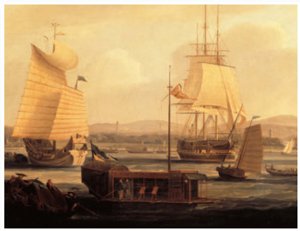Above photo: Europe’s ships wait patiently in the Pearl river while traders upstream in Canton negotiate shipments of tea. The Taipan Traders, Copyright 1992 FormAsia. Used with permission.
This is an excerpt from the July/August issue of TEA Magazine
Tea was a Chinese treasure largely unknown by Westerners when the first European ships sailed into the waters of Cathay. A shipment of 112 pounds in 1637 marked the modest beginning for the most lucrative of China’s exports. By the 18th century Britain’s tea habit alone brought the Chinese 4,400 pounds of silver a year.
Trade was well established when the ships of the East India Company embarked for London in 1770 with holds of tea from Wuyi Shan in coastal Fujian and the inland Song Luo region of Anhui Province. These chests of green and black teas, loaded in Guangzhou and warehoused in London, would eventually find their way to Boston in late 1773.
China exported tea as early as 400 AD to the Turkic peoples via the northern land routes. Sea trade, often called the “ocean silk road” was established by 700 AD. Tea made in Jiangsu, Anhui, Zhejiang and Fujian provinces shipped from the port cities of Yangzhou and Quanzhou to Japan.
Portuguese, Dutch and then British sea captains began trading in Chinese tea before the 1600’s via Macao and Java.
While the Song, Yuan and Ming dynasties imposed a strict ban on exports of tea, the Qing government (1644-1912AD) rescinded the ban and even allowed civilians to do business in tea. Enterprising businessmen from Shanxi province would travel to the tea fields of Wuyi Mountains in Northern Fujian and transport tea via the Northern Silk Road to Russia, a journey of 6,000 kilometers. The tea would then continue to Siberia and eventually make its way to Europe.



